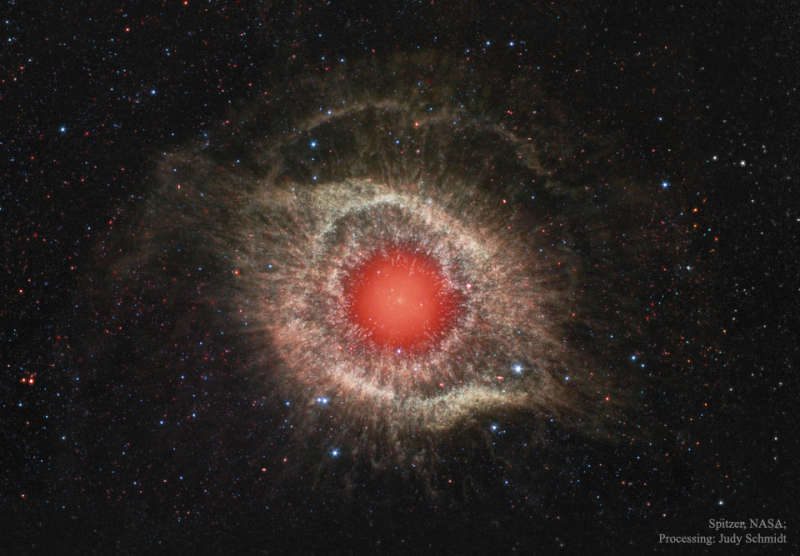Credit & Copyright: Judy Schmidt
Explanation:
What makes this cosmic
eye look so red?
Dust.
The featured
image
from the robotic
Spitzer Space Telescope
shows infrared light from the well-studied
Helix Nebula (NGC 7293) a mere
700 light-years away in the constellation of the Water Carrier
Aquarius.
The two light-year diameter shroud of
dust and gas around
a central white dwarf has long been considered an excellent
example of a
planetary
nebula, representing the final stages
in the evolution of a Sun-like star.
But the Spitzer data show
the nebula's
central star itself
is immersed in a surprisingly bright infrared glow.
Models
suggest the glow is produced by a dust debris
disk.
Even though the nebular material was ejected from the
star
many thousands of years ago,
the close-in dust could have been generated by collisions in
a reservoir of objects analogous to our own solar system's
Kuiper
Belt or cometary
Oort cloud.
Had the comet-like bodies formed in the distant planetary system,
they would have survived even the dramatic late stages of the star's
evolution.
Follow APOD on:
Facebook,
Google Plus,
Instagram, or
Twitter
1999 2000 2001 2002 2003 2004 2005 2006 2007 2008 2009 2010 2011 2012 2013 2014 2015 2016 2017 2018 2019 2020 2021 2022 2023 2024 2025 |
Январь Февраль Март Апрель Май Июнь Июль Август Сентябрь Октябрь Ноябрь Декабрь |
NASA Web Site Statements, Warnings, and Disclaimers
NASA Official: Jay Norris. Specific rights apply.
A service of: LHEA at NASA / GSFC
& Michigan Tech. U.
|
Публикации с ключевыми словами:
NGC 7293 - Helix Nebula - planetary nebula - Туманность Улитка - Планетарная туманность
Публикации со словами: NGC 7293 - Helix Nebula - planetary nebula - Туманность Улитка - Планетарная туманность | |
См. также:
Все публикации на ту же тему >> | |
